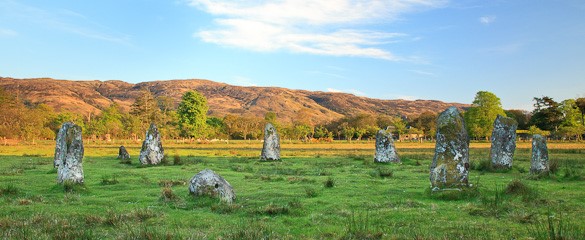Pennygown Chapel near Salen – there are two carved graves lying on the ground. These graves are of Lachlan Cattanach, former chief of Clan Maclean and his wife, they were not allowed to be buried in the chapel’s grounds due to their habit of burning live cats to summon the devil. How true am unsure … but we take guests here to see for themselves. The graveyard at Pennygown is home to the remains of ancient Pennygown Chapel. Built circa 1200ad, a Celtic cross without a head stands within the Chapel’s walls and is carved on one side with a crucifix, vegetation, a griffin (LIZ) and a highland galley and on the other the Virgin and Child. It is believed that fairies used to live here, and that they would use their magic powers to undertake small magical tasks for people who left requests here.
The stone circle at Lochbuie – The sign can be seen from the road close by. Lochbuie and Moy Castle belonging to Clan MacLaine of Lochbuie – not even a village, some houses, a chapel and a “honesty shop”. The stone circle isn’t visible from the road – a sign on the gate, a collection of white painted stones guide you to the stone circle. It is maybe 6000bc some say, but I doubt it – about 16 foot wide, with nine stones, with the tallest stone being about 5 foot high. It is composed of granite which have been positioned with their flat faces to the inside of the circle. One of the original stones has been removed and replaced with a low boulder. There are three more stones in the field at different distances from the circle. The nearest is 16 foot away and is 3 foot tall. The second is a monolith 9 foot high. The following is edited from The History of the Clan Maclean and from The Royal Commission on Ancient and Historical Monuments of Scotland, 1980, Vol. 3, Mull, Tiree, Coll & Northern Argyll.
Moy Castle stands on a low rock platform at the head of Loch Buie and was built in the 15th century by Hector MacLean, brother of Maclean of Duart and the founder of the re-named MacLaines of Lochbuie who made it their home. It is a 3 storey tower with a garret. On the centre of the ground floor there is a well with a depth of 1.8 metres. The castle was captured from the MacLaines and garrisoned by Campbells but later returned to the MacLaines. It was abandoned as a residence in 1752 when Lochbuie House was built. Building materials of the original castle were quarried from nearby Laggan. Quoins and margins to all openings are a fine-grained sandstone of greenish hue quarried at Carsaig on the Ross of Mull. Large blocks of slate paving for the parapet-walk were probably quarried from Ballachulish or Easdale. My mate ray worked on the castle some years ago, he is an archaeologist you know!
The Gaelic name is translated as ‘chapel of remembrance’ and the chapel stands close to the east shore of Lochbuie and a mile from Moy Castle. Mausoleum for the MacLaines of Lochbuie built in 1864 in memory of Donald MacLaine, 22nd of Lochbuie. A renovation took place in 1972 and on the wall by the entrance is a plaque stating:-
“This historic Chapel and Mausoleum was restored in 1972 by Brigadier Alasdair MacLean of Pennycross, ably assisted by the generosity of numerous members of the clan, kind relatives and friends from home and overseas.” The main structure appears to be late medieval, while some of the dressings may be from an earlier chapel in the same area. There is a further plaque on top of the entrance stating that the chapel was consecrated in 1500 to St. Kenneth. Nothing is known of its history and it is believed to have fallen into disuse by 1701 when the first burial took place inside the chapel. Inside the chapel is a late medieval octagonal font carved from Carsaig sandstone, and three post-reformation table-tombs bearing inscriptions to various members of the family, there is a mural monument of white marble commemorating Murdoch MacLaine 20th of Lochbuie who died in 1844. Among the gravestones is one which was erected in 1777 to commemorate the two sons, Alan and Archibald, of Donald McDonald of Taynafeigh and his wife Katharin McLean. It is interesting to note spelling; MacLean, McLean, MacLaine – so many ways of spelling this famous name. Mine too, is the McLean way, said to be the catholic spelling, similar to the Irish Mc’S. Paul McLean, Perth, June 2019

